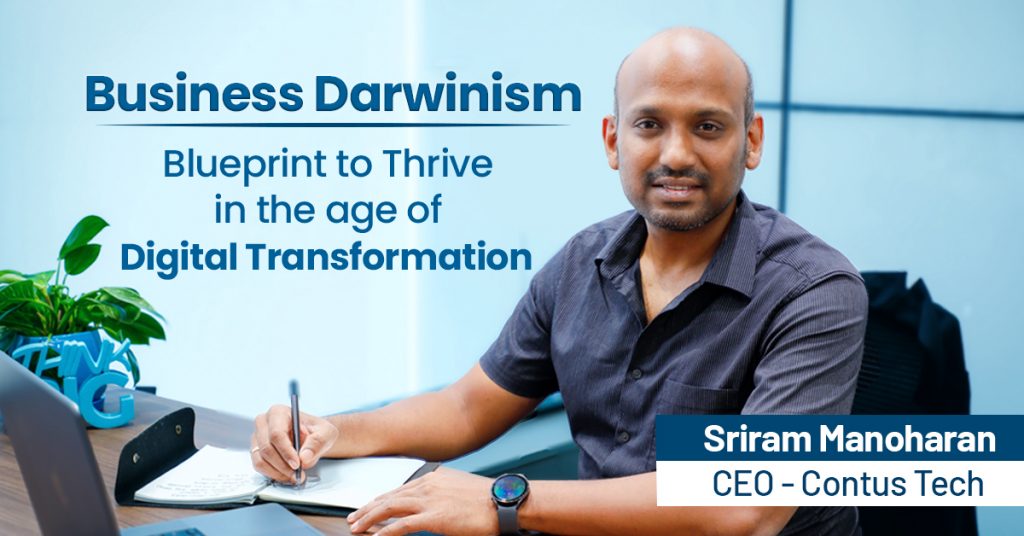Business Darwinism: Sriram Manoharan, Contus Tech CEO, Sketches Blueprint to Thrive in the Age of Digital Transformation

In the journey of business evolution, technology has always been at the heart of transformation.
In the early stages (1990-2000), the focus was on basic automation, laying the groundwork for efficiency.
By the mid-2000s (peaking around 2006), the landscape shifted, with digital channels and a customer-centric approach becoming pivotal to success.
Today, as we navigate the 2020s, the reliance on AI, Machine Learning, and IoT has become the driving force behind innovation, reshaping industries and redefining the future of digital transformation.
Digital transformation is a continuous process that involves businesses replacing existing products, services & practices with that of digitized ones.
The concept of digital transformation is integrated in our day-to-day lives to an extent we have taken it for granted. For instance, digital payments have replaced physical cash in a manner where cards & e-wallets have become the norm.
“Technology and customer-centricity are not new concepts for businesses. The key is knowing how to consider and adopt both, as this drives continuous innovation. Focus on asking How? before thinking about When? “
Table of Contents
A Retrospective on Digital Transformation
Digital transformation is anything but a recent trend, it has been in existence since the rise of computers & the internet, starting with integration of digital tools and basic automation of workflows.
Dot-com bubble
The dot-com boom and e-commerce revolution marked the first major landmark of this transformation. This fueled organizations to streamline operations, engage with customers on digital platforms & technologically optimize their offerings. As a result the NASDAQ index rose from 743 in 1995 to 5048 in 2000.
Globalization
Globalization without a doubt can be considered the major initiator for business transformation. Accelerated information transfer of business practices, exposure to new markets and innovation are few of the many benefits of an interconnected digital world.
This has reached a level in which, for every point globalization index increases the GDP per capita grows at about 0.3%.
COVID-19
The impact of 2020’s global pandemic on business transformation can’t be understated. It accelerated the digitization of businesses at a rate no one ever saw coming.
In a matter of weeks nearly every aspect of businesses turned digital, this led to significant and everlasting improvements in remote working, sales & engaging customers. As a result, the NASDAQ index more than doubled from 6,879 in March 2020 to 14,095 in October 2021.
Digital Metamorphosis: Redefining Business Strategies
Businesses’ fortune created a way for continuous transformation that remodeled their core strategies to enhance their offerings, making the market more competitive than ever.
Physical to Digital offerings
Industries that have been dominated by conventional products & services have reached heights never phathomed before post digitization. Furthermore, a shift to exclusively digital business models such as SaaS and e-commerce have marked significant milestones.
Let us consider Amazon’s venture into book retailing which began in the year 1995. The e-commerce giant rose to the position of the largest bookseller in the world, selling $5B worth of books annually.
However, Amazon didn’t settle and chose to completely digitize their offering and launched the Kindle, an e-reader in 2009. The product now holds a market share of 72% and is a forerunner in the e-publishing industry.
Product to Customer-centric models
Yet another massive change in the business model is the shift from product-centric offerings to customer-centric ones. With this evolution, businesses prioritize customer relations rather than focusing solely on enhancing products.
While digitally transformed products have been at the spotlight for years, practices have largely gone under the radar. Washington state’s public transport provider Sound Transit, rather than extending their offerings chose to optimize existing ones.
Sound Transit leveraged cloud systems to integrate & synchronize vehicles with time tables. This offered real-time updates to users enhancing their travel experience significantly. This has led to overall growth in the organization’s finances as they increased their net position from $15.9B in 2021 to $20.6B in 2023.
Data-driven customizations
This new found emphasis on customers has led to businesses offering better customer services. This has been primarily made possible by data-driven decisions. Vast data collections and analysis has facilitated product optimization, personalized marketing & high levels of customized offerings.
DHL’s adoption of AI & ML to ensure quality control and a transparent data analysis on deliveries, issues and tracking has made the logistics giant immensely popular among B2B and B2C clients. This can be inferred from their most recent public survey conducted across 40 countries which saw an increased rating in 211 categories.
The Art and Science of Digital Leadership
Leadership qualities essential for digital transformation
Effective digital transformation can only be achieved under driven leadership. The right blend of adaptability, strategy and vision is incumbent in this complex and ever evolving digital business landscape. Another crucial skillset is the ability to understand customer needs and act upon them.
Balancing innovation with risk management
Driving innovation while keeping risk at check is an intricately delicate art. Experimenting and upgrading to evolving technology is crucial in staying competitive in the cutthroat market. However, it should be taken on after thorough analyses of risk tolerances and the organization’s resources, capabilities & vision.
Nevertheless, the primary role of leadership is to inspire & empower growth through dynamic transformation. Formulating clear guidelines and workflows can establish a risk-managed framework.
The Technological Quadrivium Empowering Digital Transformation
The upcoming few years of business transformation is primarily expected to be dominated by artificial intelligence (AI), Internet of Things (IoT), blockchain and cloud computing.
The AI Advantage: Zara’s Inventory optimization
Artificial Intelligence along with machine learning promises to be the most decisive tool across all streams in business and beyond. Digital Transformation is no exception, with automation, predictive analyses & customization set to play major roles.
Zara’s inventory management using AI is an excellent example. The organization’s inventory turnover ratio as of April 2024 is 12, which is 3-4 times higher than their competitors. Their sell through is an impressive 85%.
The IoT Transformation in Barcelona
With the amount of data collected & processed nowadays, smart devices connected to the digital world would be massive.
The city of Barcelona’s transformation into a smart city is one of the better uses of IoT, in which, the city’s parking spaces, transport systems and air quality index have all been monitored and optimized. Resonance Consulting ranked the Catalonian city as the 8th best city in the world in 2024.
Cloud computing’s Footprint in Digital Banking
Numerous industries and organizations have and will be benefited by the power of scalable infrastructure using cloud computing.
Fukuoka Financial Group that operates Fukuoka Bank, formed Minna Bank in 2019, one of the earliest completely digital banks, harnessing the power of cloud computing. The Japanese bank is valued in excess of $100M.
Renault’s Resurgence with Blockchain
This technology, ensuring paramount security and transparency for transactions is the future of global trade.
Renault in collaboration with IBM has leveraged blockchain for component traceability in a European automotive regulatory compliant manner. As a result, Renault after four years of declining sales, in 2023 reported a 19.7% increase in global sales. Furthermore, they expect this to reach 40% in 2024.
The Convergence of Technology and Business Strategy
Quantum computing & extended reality are two technologies certain to dominate digital transformation in the coming decades.
Organizations that have achieved continuous growth over the years are those that have always grabbed opportunities and innovations available. This race for adaptability is only set to grow further and further.
A continuously evolving and digitally updated organization necessitates a culture of experimentation, innovation and risk management. Embracing agile techniques and adapting to market changes is crucial. This culture shouldn’t stop with management but be enriched with the employees as well.
“Change is indeed the constant universal factor; Innovation and a relentless pursuit of excellence is not far off”



